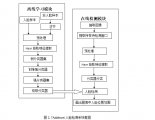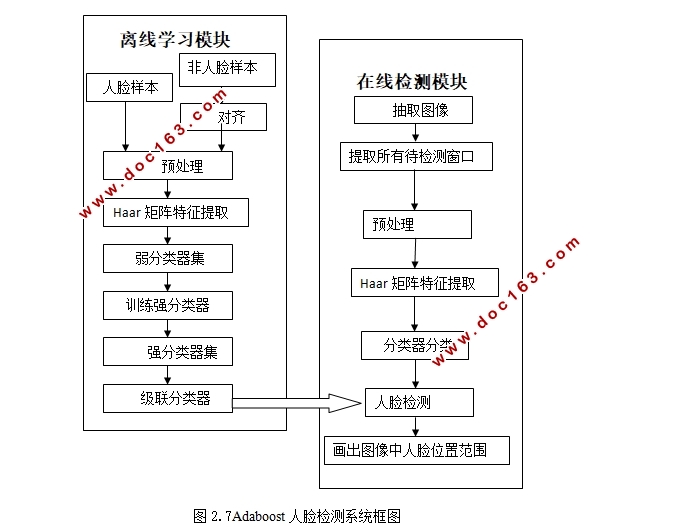基于子空间的人脸检测系统设计

基于子空间的人脸检测系统设计(任务书,开题报告,论文11000字)
摘要
人脸识别是现如今模式识别的热门研究方向,也是图像处理领域的重要研究课题。而人脸检测是人脸识别的第一步,只有先从静止图像或视频当中检测出人脸,才能够进行人脸的特征提取和匹配识别。人脸检测(Face Detection,FD)是指采取特定的技术方法判断图像中是否存在人脸,如果是,就确定人脸的位置,大小,和姿态。因此,人脸检测问题的研究具有重要意义。
本文首先对比分析了现今主流的人脸检测方法,然后基于VC++和OpenCV工具,利用adaBoost算法实现了人脸检测系统设计——能够在给定的彩色或灰度静止图像中判断是否存在人脸区域,并进一步确定人脸的位置。紧接着,本文提出基于子空间的人脸识别方法。最后,对本次设计进行总结归纳与展望。
本次设计的人脸检测系统能够快速并准确地实现从静止图像中检测和标示出人脸位置的功能,为以后的人脸识别设计打下坚实的基础。
关键词:人脸检测;子空间;adaBoost算法;人脸识别
Abstract
Face recognition is an important research topic now as well as an popular pattern of recognition research in the field of image processing. The face detection is the first step of face recognition, only detecting a person's facefrom still images or video, can we able to perform face recognition feature extraction and matching.Face Detection refers to input an image, take specific technical methods for image search, which determine whether there is a face, if it is, then determined face position, size, and posture. Therefore, the study of face detection is important.
[资料来源:http://Doc163.com]
Firstly, the comparative analysis of today's mainstream face detection methods, and then based on VC ++ and OpenCV tools, using adaBoost algorithm design face detection system --which determined whether the face region exists in a given color or grayscale still images, and further determines the position of the face. Then proposed face recognition method based on subspace. Finally, this design will be summarized and prospect.
The design of the face detection system can quickly and accurately detect and mark the position of the face from the still image, and lay a solid foundation for future recognition design.
Key Words:Face detection; subspace; adaBoost algorithm; face recognition
[资料来源:www.doc163.com]


目录
第1章绪论 1
1.1课题研究背景及意义 1
1.2国内外研究现状 1
1.3人脸检测方法综述 2
1.3.1基于几何特征的方法 2
1.3.2基于肤色模型的方法 2
1.3.3基于统计理论的方法 3
1.4本文的主要工作和内容安排 3
第2章基于AdaBoost算法的人脸检测原理 4
2.1AdaBoost算法的提出 4
2.2矩形特征 5
2.2.1Haar-like矩形特征 5
2.2.2子窗口条件矩形及特征个数计算 5
2.3积分图 7
2.3.1积分图的概念 7
2.3.2利用积分图计算特征值 7
2.4弱分类器 8
2.5训练强分类器 9
2.6图像检测过程 10
第3章系统设计方案与实现 12
3.1OpenCV简介 12
3.2 VC++上配置OpenCV 12
3.3主程序设计 12
3.4系统测试结果与分析 14
3.5系统界面设计 16
第4章基于子空间的人脸识别方法 17
4.1人脸识别流程 17
4.2线性子空间分析方法 17
4.2.1主成分分析方法(PCA) 17
4.2.2线性判别分析方法(LDA) 19
4.3非线性子空间分析方法 19
第5章总结与展望 20
参考文献 21
附录 22
附件一 22
致谢 25 [资料来源:http://www.doc163.com]
